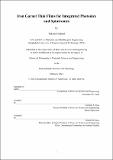Iron Garnet Thin Films for Integrated Photonics and Spintronics
Author(s)
Fakhrul, Takian
DownloadThesis PDF (30.95Mb)
Advisor
Ross, Caroline A.
Terms of use
Metadata
Show full item recordAbstract
In pursuit of beyond CMOS computing, this thesis aims to provide material solutions for both photonic interconnects and ultra-fast spintronic memory. Iron garnet thin films are uniquely suited for both applications as they have: 1) strong magneto-optic (MO) response and low optical absorption at communication wavelengths making them enablers for nonreciprocal devices essential in photonic integrated circuits. 2) Low Gilbert damping and perpendicular anisotropy (PMA) that promote fast DW dynamics making them exciting candidates for next generation spintronic memory.
We first study polycrystalline in-plane magnetized iron garnets for optical isolation. The first successful demonstration of top-down crystallized polycrystalline BiYIG/YIG films on Si exhibit a record high MO figure of merit (FoM) of up to 770° dB⁻¹ at 1550 nm wavelength. Growth of single phase BiYIG on the sidewalls of waveguides is also demonstrated, which can be used in transverse electric-mode devices. Tb₃Fe₅O₁₂ (TbIG), CeTbIG, and BiTbIG films are grown directly on Si substrates without any seed layers. The Faraday rotation at 1550 nm of the Bi₀.₀₃TbIG films is 6200 ± 300° cm⁻¹, which is the highest reported for polycrystalline films, and absorption can be engineered by composition control that may reduce Fe²⁺ and Tb⁴⁺ absorption pathways. We then study single crystal BiYIG with PMA and ultra-low Gilbert damping in the order 1.3× 10⁻⁴ . These films exhibit record spin-orbit torque-driven domain wall (DW) velocities of up to 4300 m/s, but require an in-plane field. We show that Dzyaloshinskii–Moriya interaction (DMI) can be introduced in heterostructures of BiYIG and TmIG and report the first proof-of-concept of field-free current induced DW motion in Pt/BiYIG/TmIG stacks, as well as formation of room temperature skyrmions.
Date issued
2022-02Department
Massachusetts Institute of Technology. Department of Materials Science and EngineeringPublisher
Massachusetts Institute of Technology